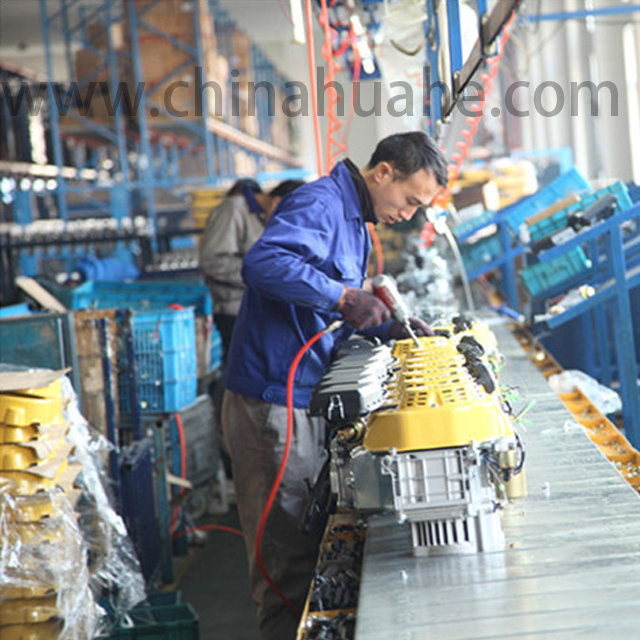HH1500/HH2500/HH950
HuaHe
The carburetor function is a mechanical device that mixes a certain proportion of gasoline and air under the action of the vacuum generated by the engine operation. As a precision mechanical device, the carburetor uses the kinetic energy of the inhaled air flow to achieve gasoline atomization, and its important role in the engine can be called the heart of the engine. The complete device of the carburetor shall include a starting device, an idle device, a medium load device, a full load device and an acceleration device. The carburetor will automatically match the corresponding concentration and output the corresponding amount of mixture according to the different working conditions of the engine. In order to make the mixture mixed evenly, the carburetor also has the effect of fuel atomization for the normal operation of the machine.
Product Type:Spare Parts of Gasoline Generator
Model:HH950/HH1500/HH2500
Product Name:Carburetor
Usage:Gasoline Generator
Packing:Customized
Certificate:ISO9001
The carburetor of a gasoline generator is a key component of the engine's fuel system. It is responsible for mixing air and fuel in the correct proportions to create a combustible mixture that powers the engine. Here are some key points about the carburetor:
1. Function: The primary function of the carburetor is to atomize and mix the fuel with the incoming air to create a combustible mixture. This mixture is then delivered to the engine's combustion chamber for ignition and power generation. The carburetor controls the fuel flow based on the engine's speed and load requirements.
2. Design: The carburetor is typically a metal or plastic housing that contains several internal components, including a venturi, throttle plate, fuel jets, float bowl, and various valves. These components work together to regulate the air and fuel flow and maintain the correct fuel-air mixture for optimal engine performance.
3. Operation: When the engine is running, air is drawn into the carburetor through the air intake. As the air passes through the venturi, it creates a low-pressure area that draws fuel from the float bowl through the fuel jets. The throttle plate controls the amount of air entering the carburetor, which in turn regulates the fuel flow. The mixture is then delivered to the engine's intake manifold for combustion.
4. Adjustment: Carburetors often have adjustable settings to fine-tune the fuel-air mixture for different operating conditions. These adjustments may include the idle speed, idle mixture, and high-speed mixture. Proper adjustment ensures optimal engine performance, fuel efficiency, and emissions control. It is important to follow the manufacturer's guidelines and specifications for carburetor adjustments.
5. Maintenance: Regular maintenance of the carburetor is important to ensure proper fuel delivery and performance. This includes cleaning the carburetor to remove any dirt or debris that may clog the fuel jets or passages. It is also important to inspect and replace any worn or damaged components, such as gaskets or seals, to prevent fuel leaks or improper fuel-air mixture.
6. Replacement: In some cases, if the carburetor is severely damaged or cannot be repaired, it may need to be replaced. Replacement carburetors should be compatible with the specific generator model and engine specifications. It is recommended to consult the generator's user manual or contact the manufacturer for guidance on the specific replacement procedure and compatible parts.
In summary, the carburetor of a gasoline generator is responsible for mixing air and fuel to create a combustible mixture for the engine. Regular maintenance and proper adjustment are crucial for optimal performance and fuel efficiency.

Advantages
1.100% testing with loaded before packing.
2.With ISO9001 certification.
3.Reasonable price with higher quality.




The carburetor function is a mechanical device that mixes a certain proportion of gasoline and air under the action of the vacuum generated by the engine operation. As a precision mechanical device, the carburetor uses the kinetic energy of the inhaled air flow to achieve gasoline atomization, and its important role in the engine can be called the heart of the engine. The complete device of the carburetor shall include a starting device, an idle device, a medium load device, a full load device and an acceleration device. The carburetor will automatically match the corresponding concentration and output the corresponding amount of mixture according to the different working conditions of the engine. In order to make the mixture mixed evenly, the carburetor also has the effect of fuel atomization for the normal operation of the machine.
Product Type:Spare Parts of Gasoline Generator
Model:HH950/HH1500/HH2500
Product Name:Carburetor
Usage:Gasoline Generator
Packing:Customized
Certificate:ISO9001
The carburetor of a gasoline generator is a key component of the engine's fuel system. It is responsible for mixing air and fuel in the correct proportions to create a combustible mixture that powers the engine. Here are some key points about the carburetor:
1. Function: The primary function of the carburetor is to atomize and mix the fuel with the incoming air to create a combustible mixture. This mixture is then delivered to the engine's combustion chamber for ignition and power generation. The carburetor controls the fuel flow based on the engine's speed and load requirements.
2. Design: The carburetor is typically a metal or plastic housing that contains several internal components, including a venturi, throttle plate, fuel jets, float bowl, and various valves. These components work together to regulate the air and fuel flow and maintain the correct fuel-air mixture for optimal engine performance.
3. Operation: When the engine is running, air is drawn into the carburetor through the air intake. As the air passes through the venturi, it creates a low-pressure area that draws fuel from the float bowl through the fuel jets. The throttle plate controls the amount of air entering the carburetor, which in turn regulates the fuel flow. The mixture is then delivered to the engine's intake manifold for combustion.
4. Adjustment: Carburetors often have adjustable settings to fine-tune the fuel-air mixture for different operating conditions. These adjustments may include the idle speed, idle mixture, and high-speed mixture. Proper adjustment ensures optimal engine performance, fuel efficiency, and emissions control. It is important to follow the manufacturer's guidelines and specifications for carburetor adjustments.
5. Maintenance: Regular maintenance of the carburetor is important to ensure proper fuel delivery and performance. This includes cleaning the carburetor to remove any dirt or debris that may clog the fuel jets or passages. It is also important to inspect and replace any worn or damaged components, such as gaskets or seals, to prevent fuel leaks or improper fuel-air mixture.
6. Replacement: In some cases, if the carburetor is severely damaged or cannot be repaired, it may need to be replaced. Replacement carburetors should be compatible with the specific generator model and engine specifications. It is recommended to consult the generator's user manual or contact the manufacturer for guidance on the specific replacement procedure and compatible parts.
In summary, the carburetor of a gasoline generator is responsible for mixing air and fuel to create a combustible mixture for the engine. Regular maintenance and proper adjustment are crucial for optimal performance and fuel efficiency.

Advantages
1.100% testing with loaded before packing.
2.With ISO9001 certification.
3.Reasonable price with higher quality.




